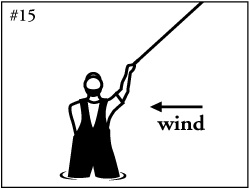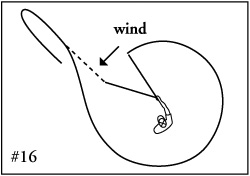Crosswinds
Crosswinds complicate casting. In Diagram 15 a wind blows the line onto the caster’s body. This presents a handicap because the casting stroke can pass the fly dangerously close to your body. Compensate by making shorter casts or if possible repositioning yourself across the stream where the wind blows the casting line away from you. The position of the caster is an advantage because the casting planes are directed away from your body and the backcast stroke doesn’t cross your body.
Additionally, crosswinds complicate a natural drift and require additional line mending. Reach casts are useful in cross winds.

Circle Cast
The circle cast is used for casting when the wind blows the line back onto your body. Both the forward and the backcasts are made with the rod held high over your head and with the casting planes oriented towards your downwind side. This allows the casting line to safely travel away from your body. This casting plane is assisted by the wind, making it travel somewhat in a circle. (See Diagram 16)


© 2025 The Gale Group, Inc. All rights reserved.
© 2025 Perigee Learning LLC. All rights reserved.
LoveTheOutdoors.com is owned and operated by Advameg, Inc. © 2025 Advameg, Inc.
Camping Adventures • Dutch Oven Cooking • Sports Knots
Fly Tying • Freshwater Fishing • Fly Fishing

